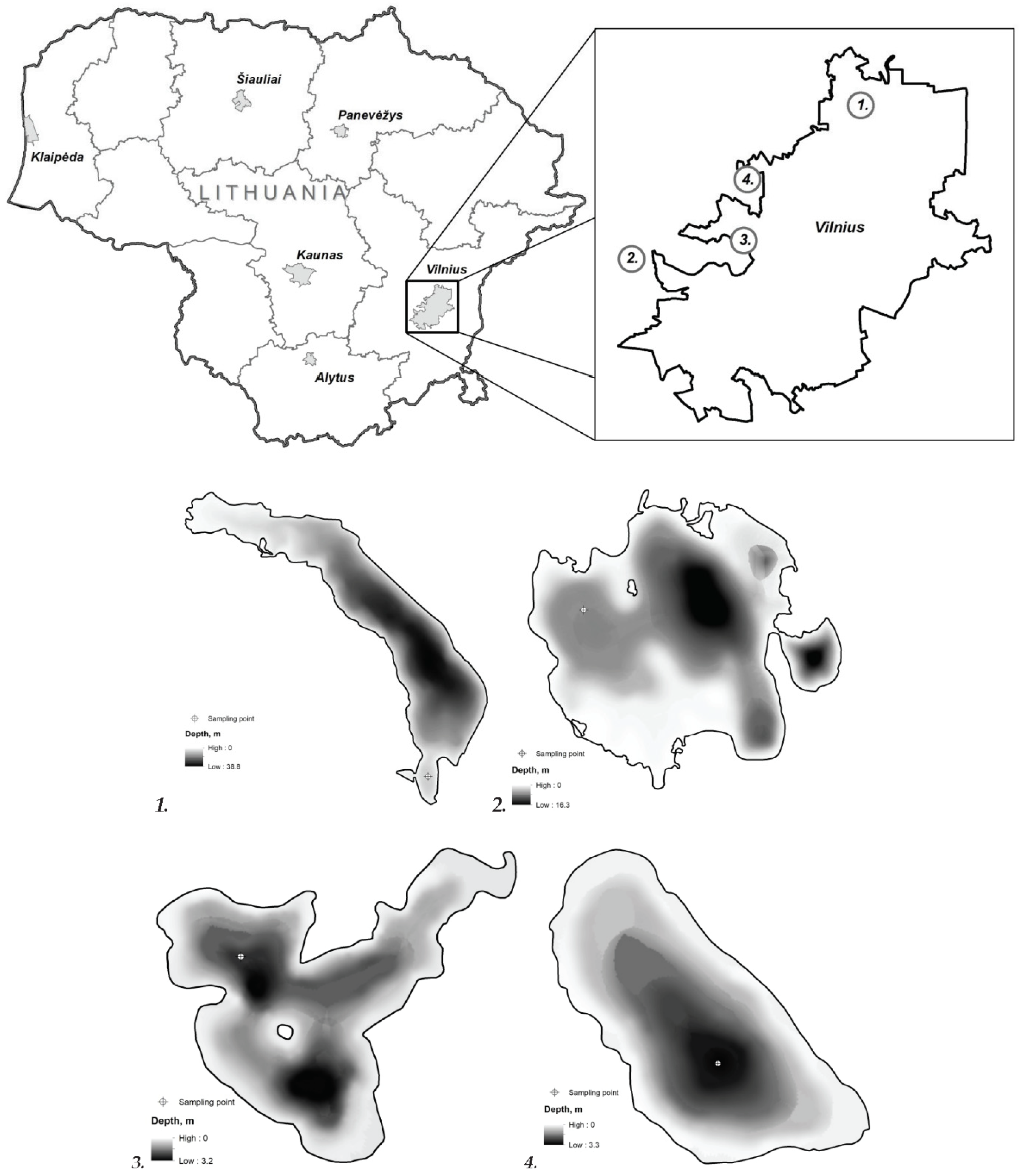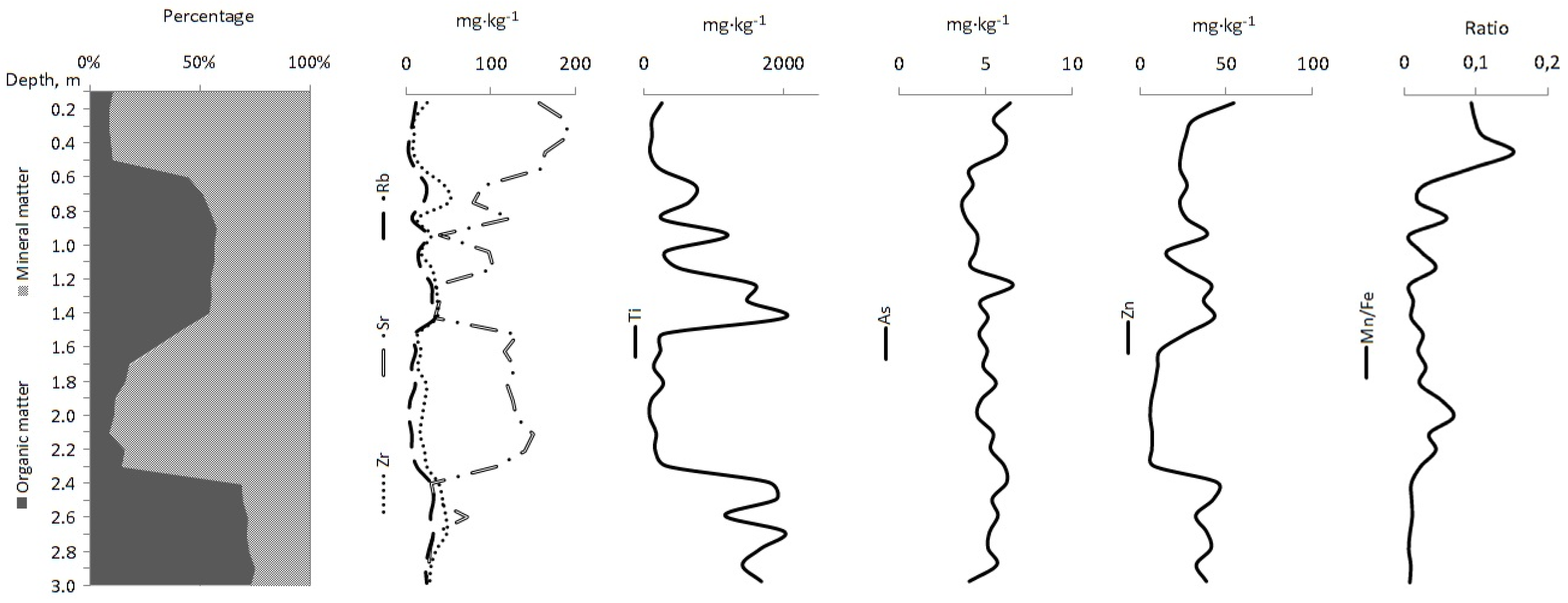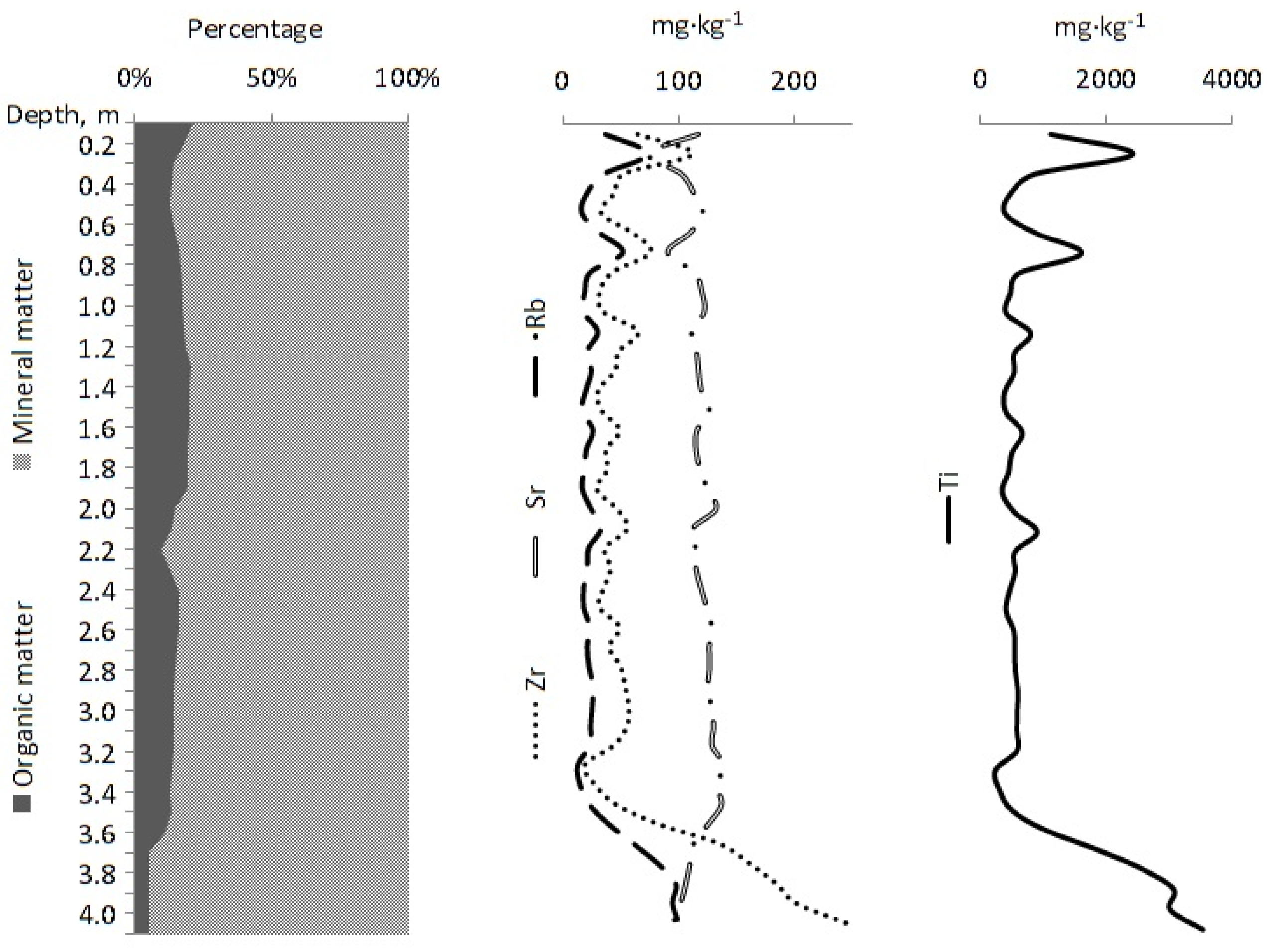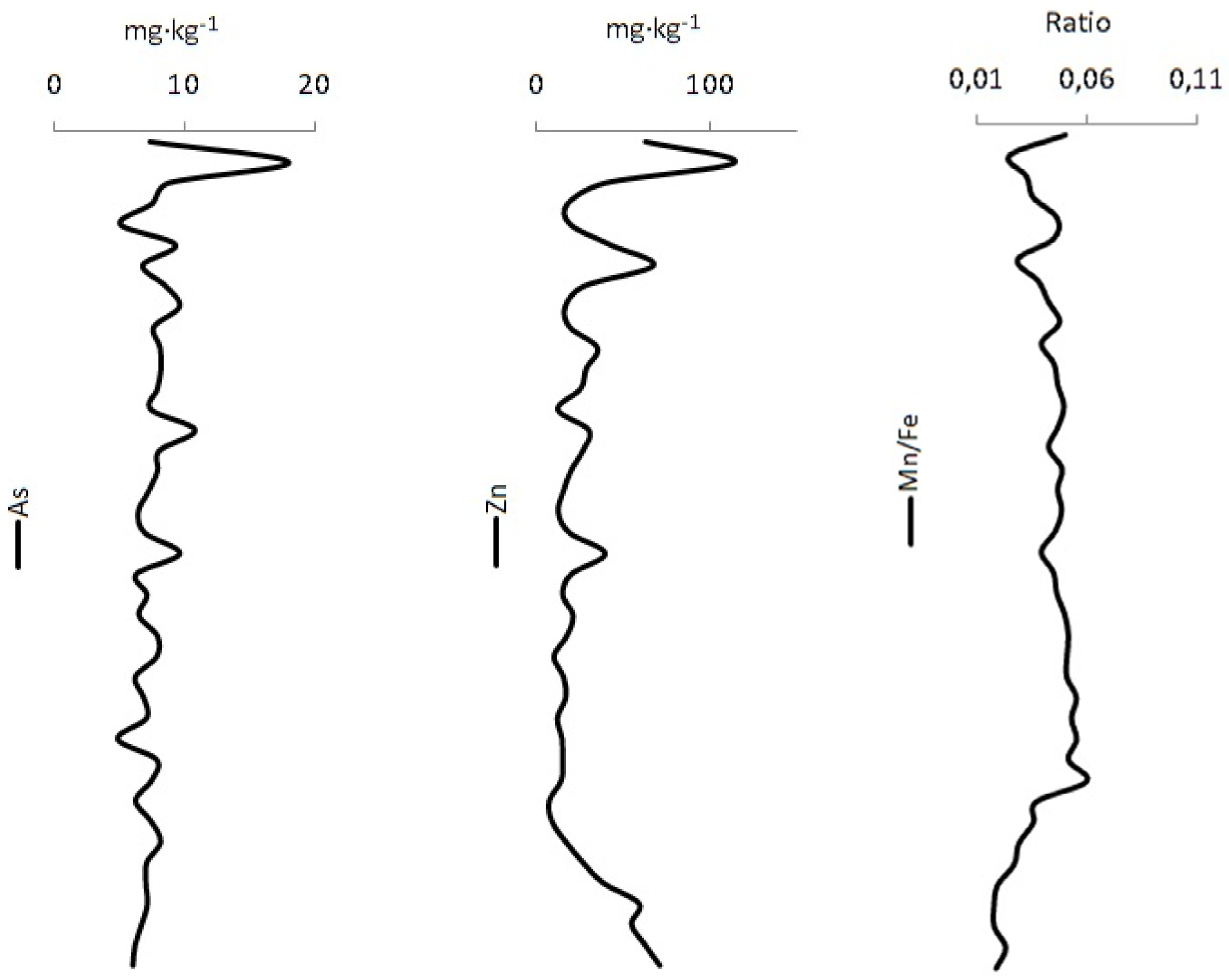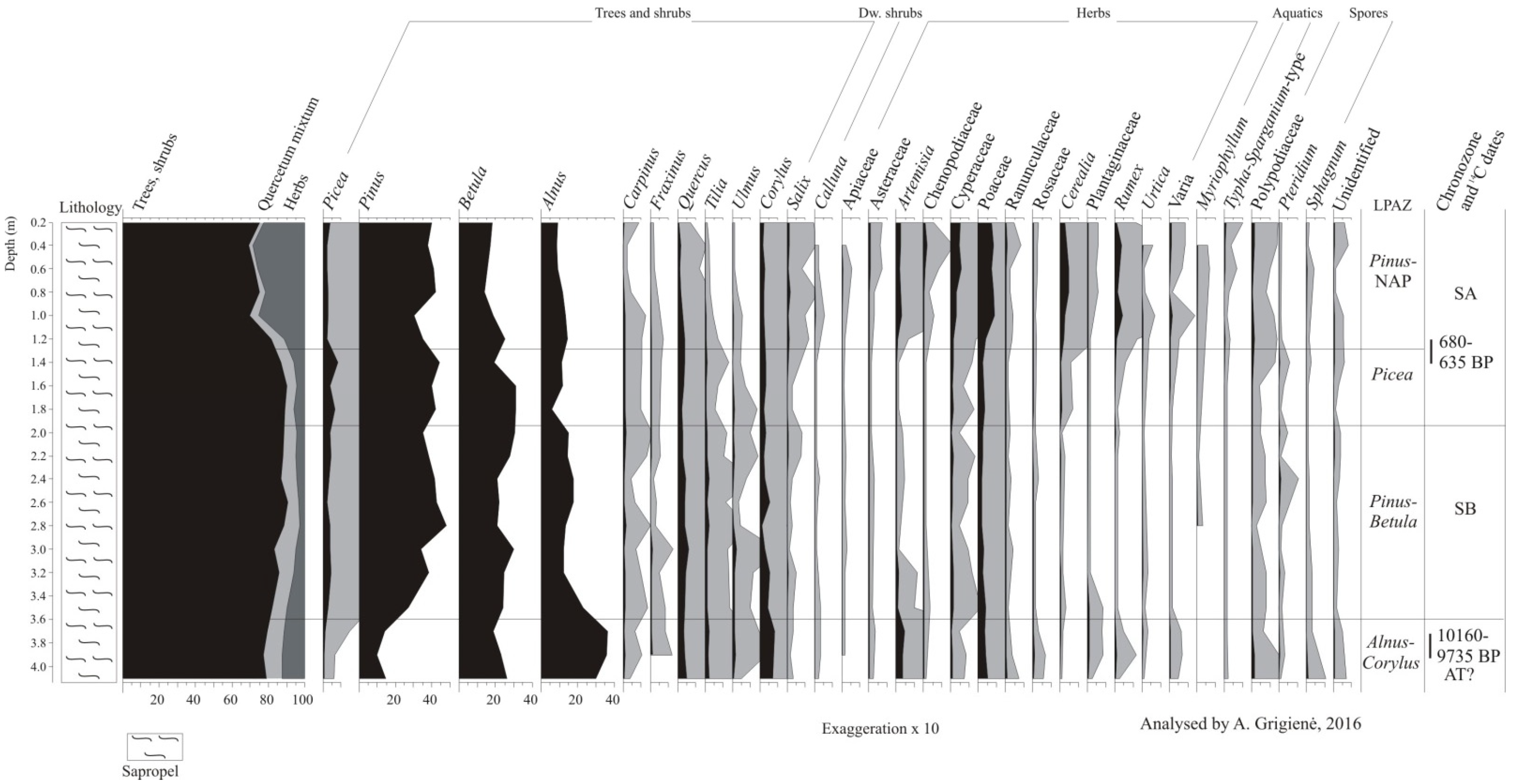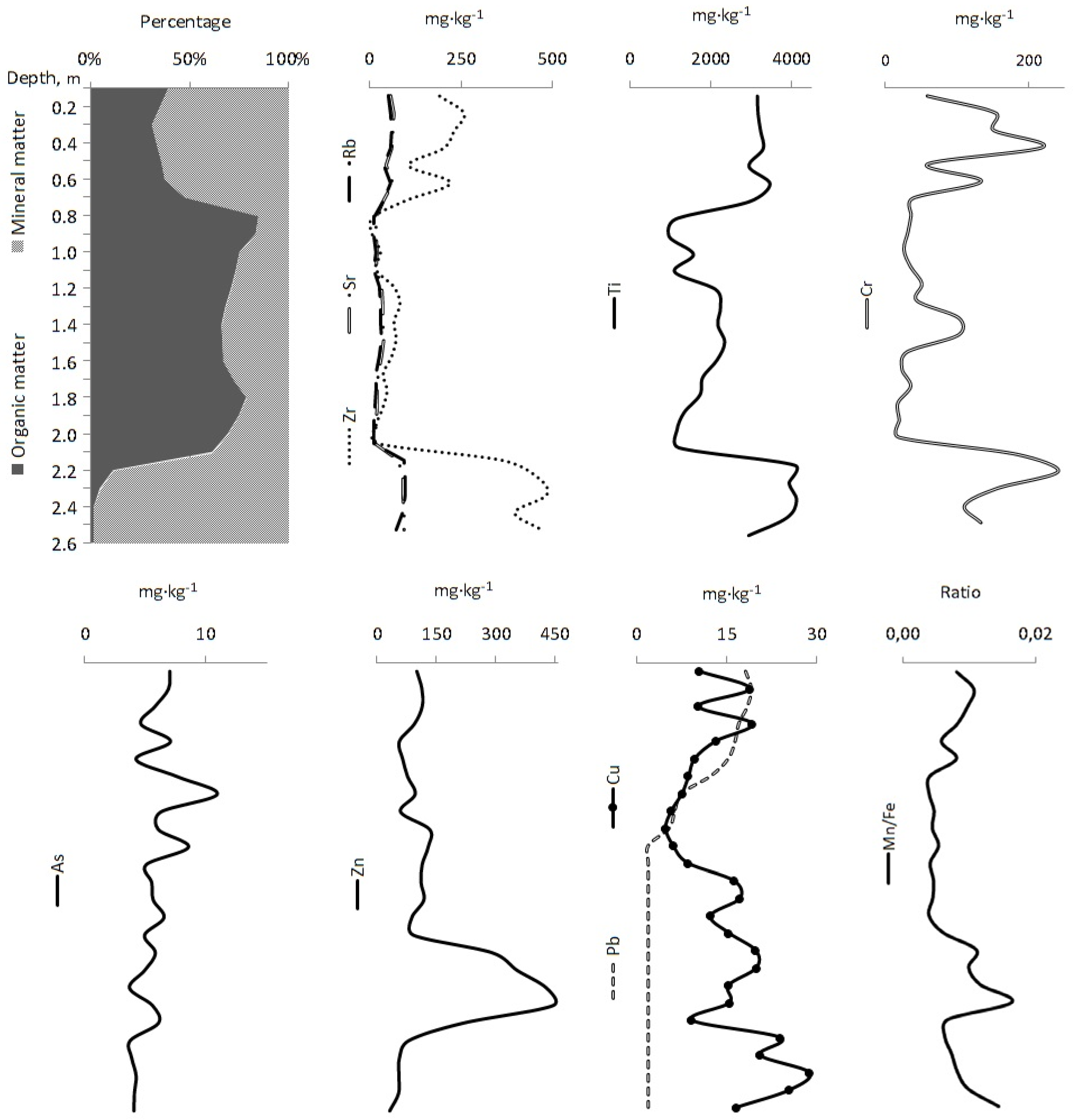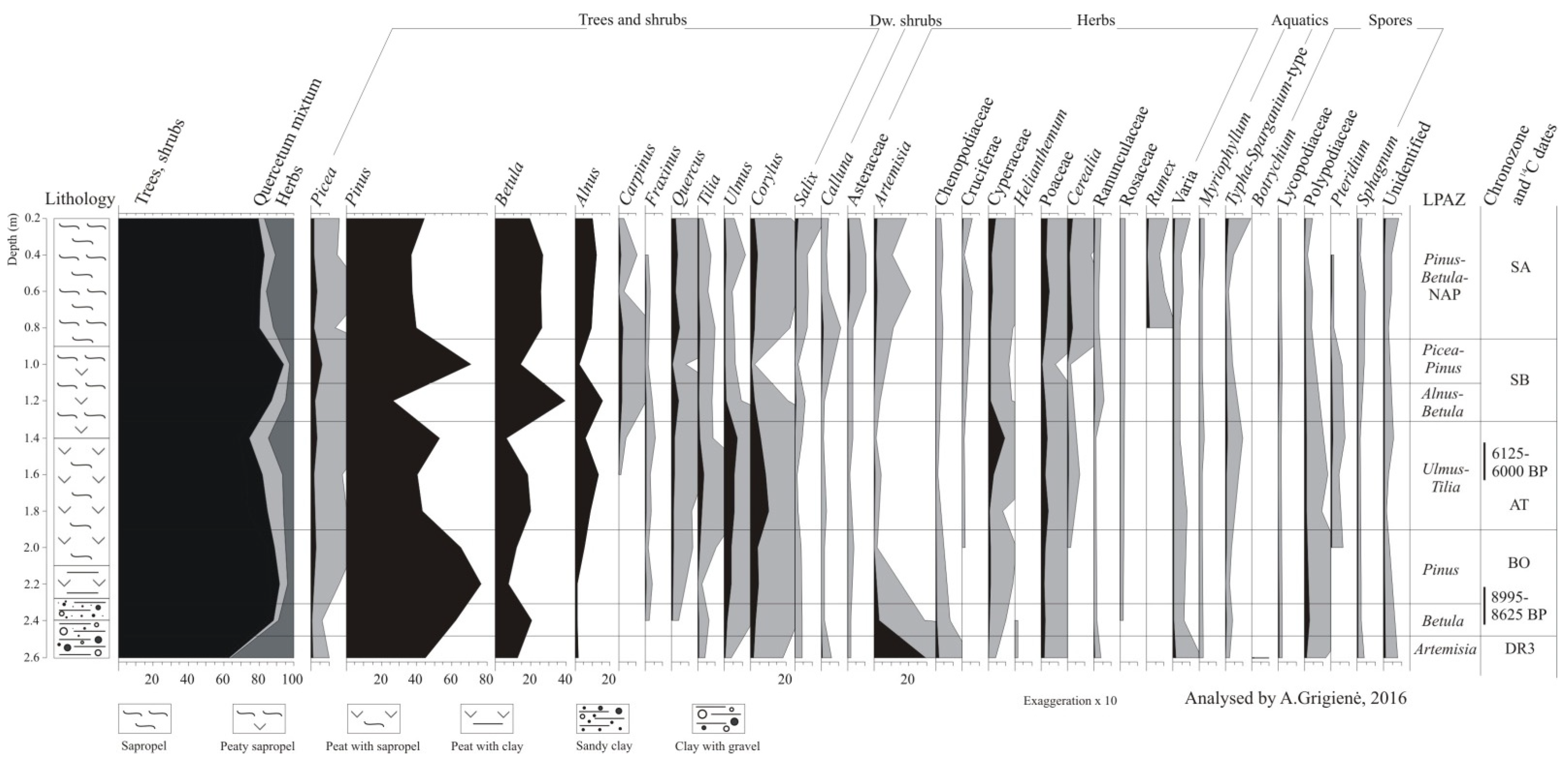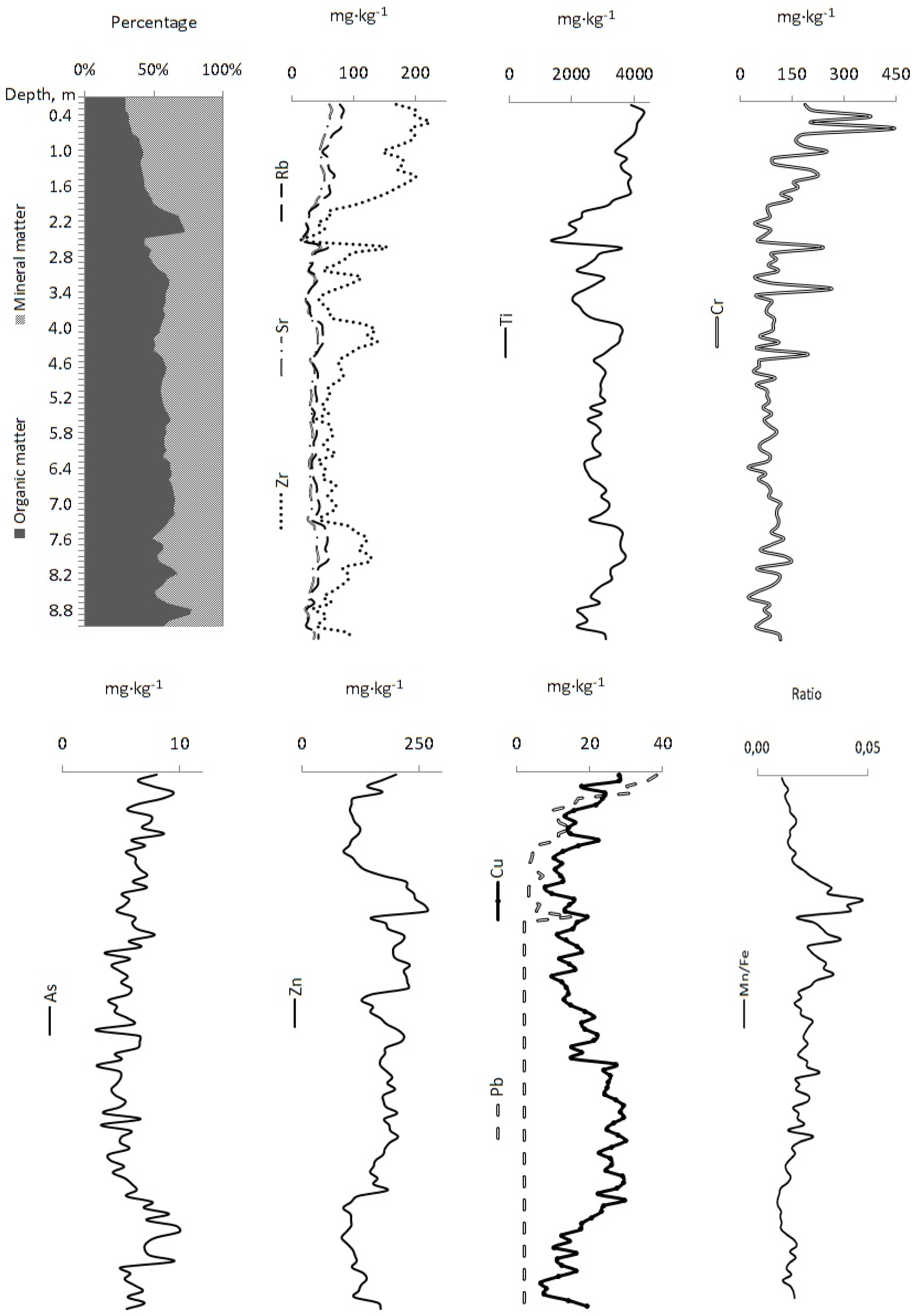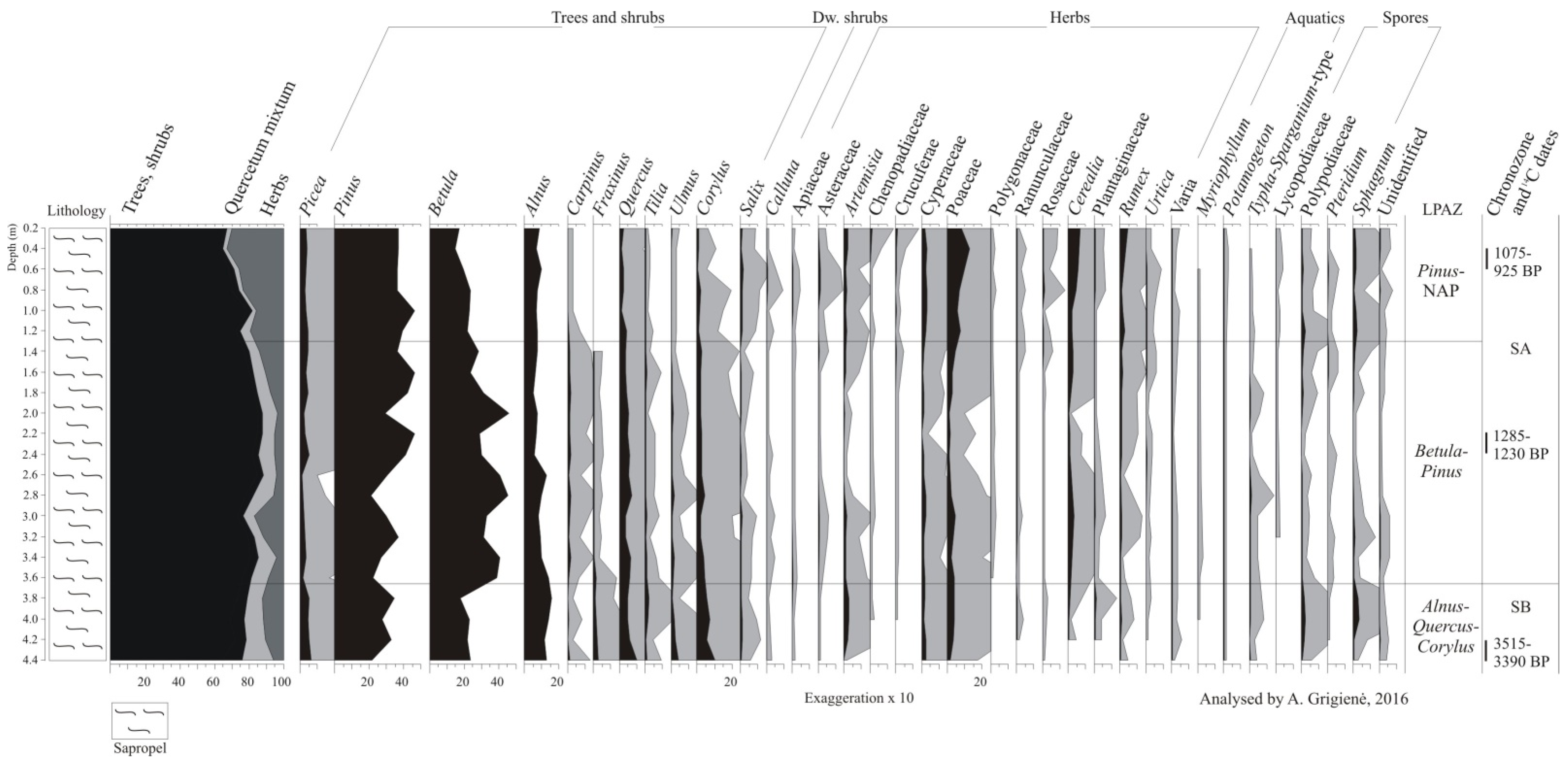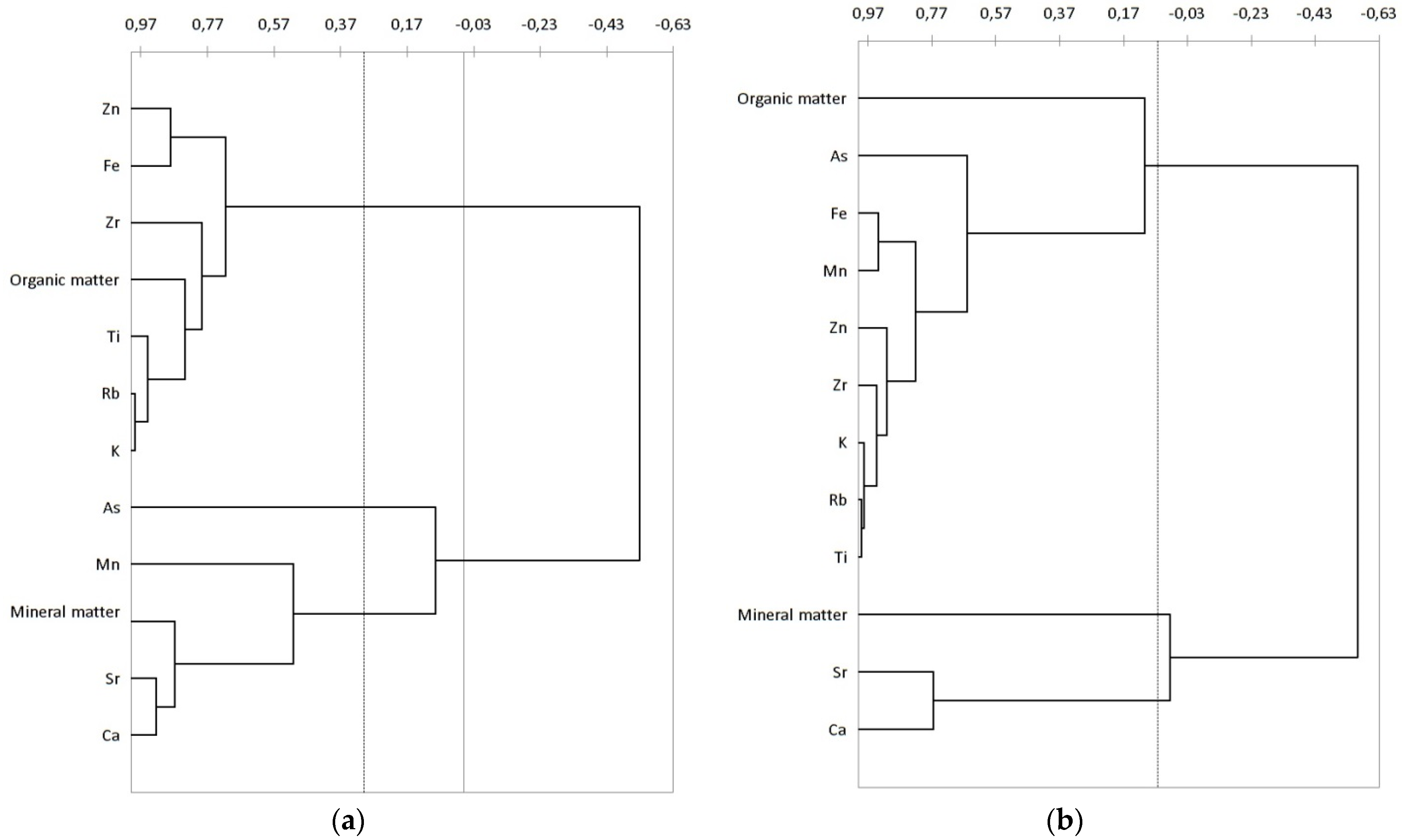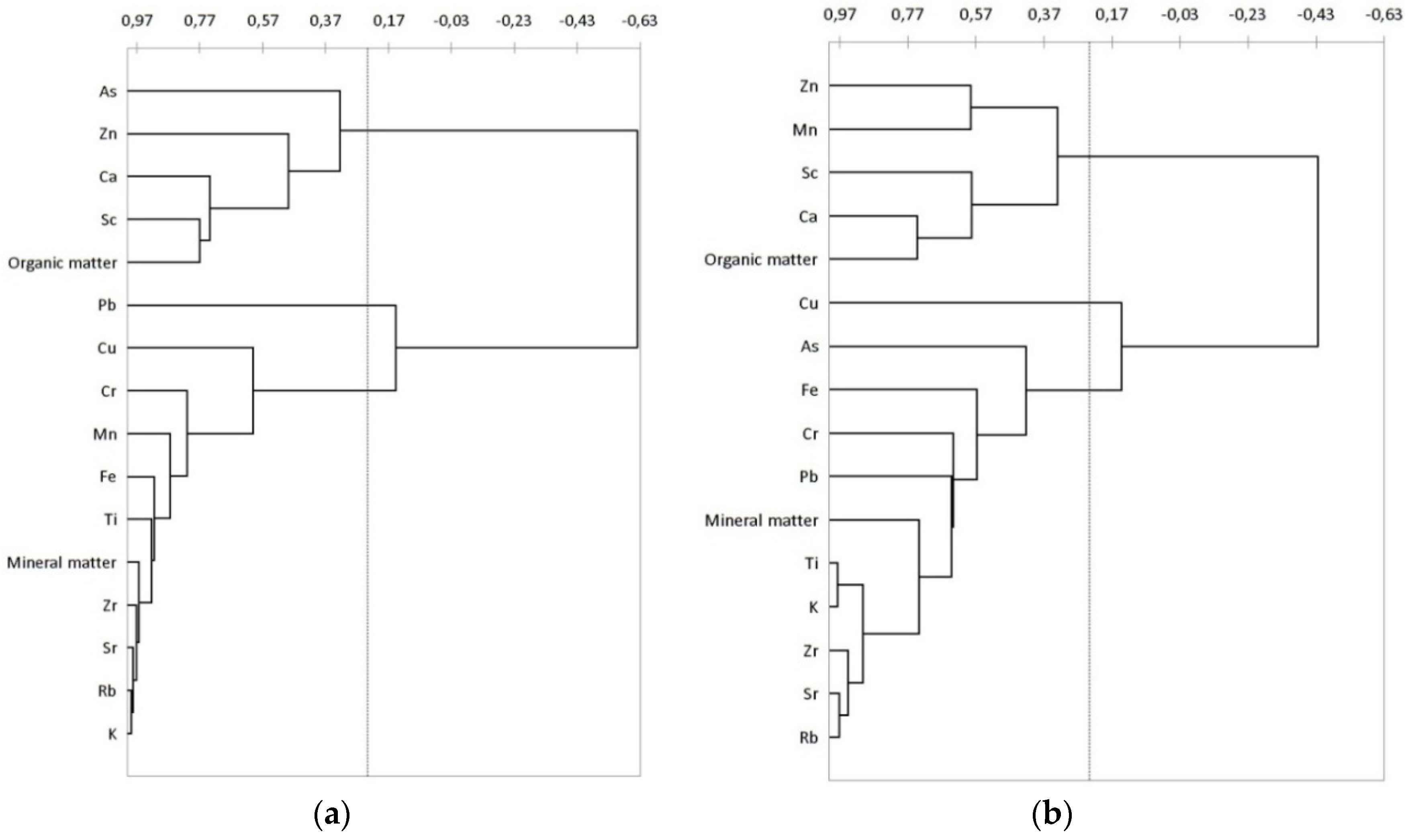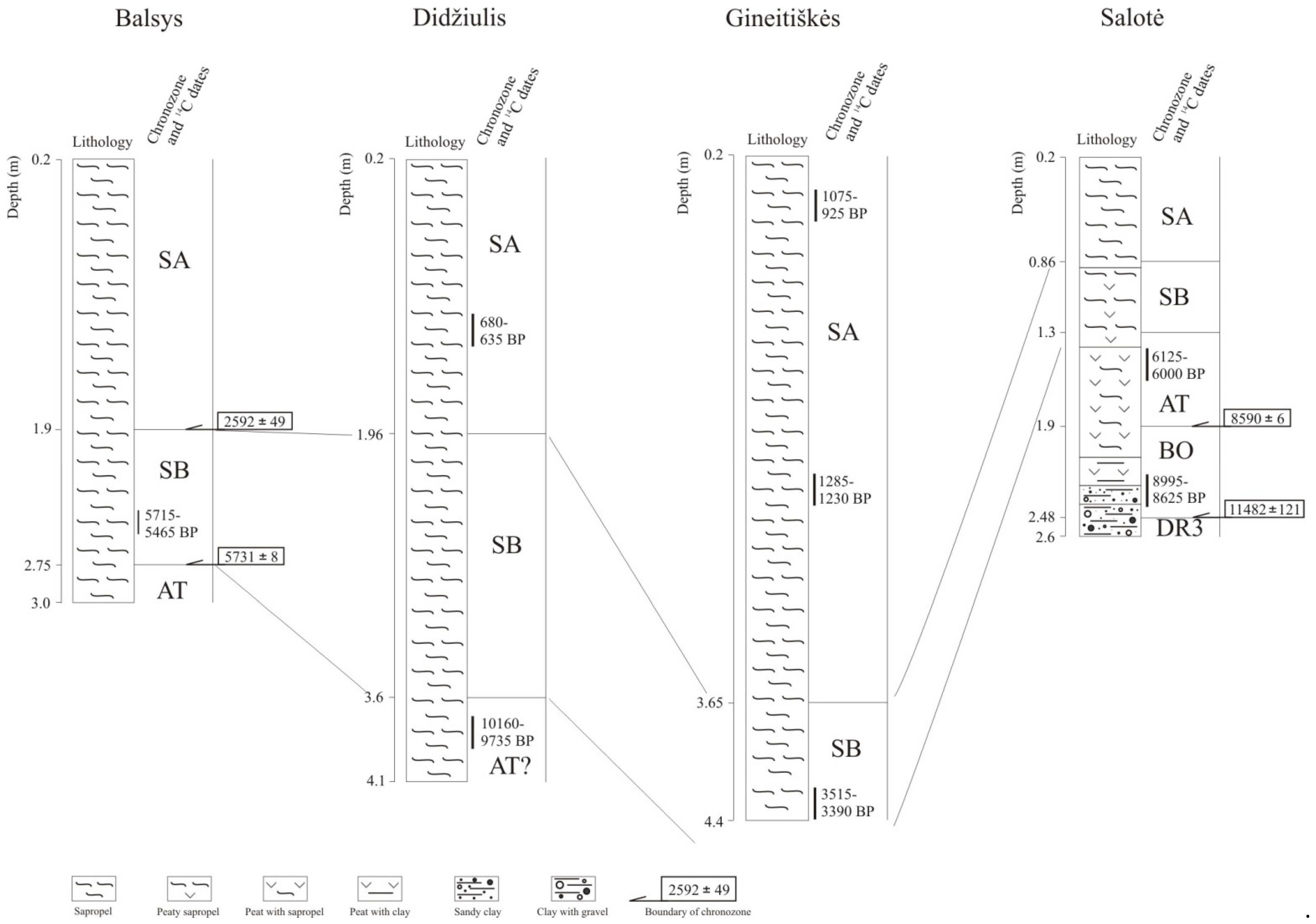1. Introduction
Lakes continuously accumulate sediments after the formation of their basins and the time for development can last for several thousand years or even longer, dependent on paleoenvironmental conditions. The study area occurs in the zone of glacial formations of the Last (Late Weichselian) glaciation and the lacustrine sedimentation history is mainly Late Glacial and Holocene. The sediments include biogenic components originating in the lake and delivering from its catchment area as well as soil particles and other abiogenic materials transported by rivers and winds. Sapropels are types of fine organogenic sediments commonly found in lakes in the North Temperate Zone [
1,
2,
3]. According to the classification of lacustrine sediments used in Lithuania [
4], the sapropel is water laid very fine material containing more than 15% of organic matter and, depending on the amount of admixture, can be organic, carbonatic, sandy, silty or clayey.
Sapropels form under interaction of biological, chemical and physical processes that take place in the catchment area and lake itself. The intensity and combination of these processes are very variable depending on the different geological and geomorphological settings, hydrological regimes and atmospheric conditions, as well as human activities [
5,
6,
7]. Analysis of sapropel composition is important for determination of its quality as potential raw material, impact of anthropogenic activity and also paleoenviromental conditions and dynamics of lake ecosystems.
Hydroclimatic conditions essentially influence the manner and intensity of transport of lithogenic elements from the catchment area to the lake. During warm and wet periods, chemical weathering might be induced. Dry periods with sparse vegetation cover may cause an increase of physical weathering. Greater amounts of dust transportation result from physical weathering which is more intense during cold periods with limited vegetation cover (deforestation, intensity of agriculture, etc.). Concentrations of trace metals are usually affected by anthropogenic atmospheric deposition. These different conditions influence changes of the sediment geochemistry [
8,
9,
10]. In addition to the geochemical composition of sapropels, pollen analysis is very important as it provides information about vegetation cover in the catchment area of the lake at a given time. It allows reconstruction of the dynamics of past vegetation and provides climatostratigraphical data for determination of age of sediments [
11,
12,
13].
Concentrations of heavy metals in sapropel layers can be very uneven. Most of the heavy metals, before settling to the bottom sediments, are in colloidal or suspended phases in the aquatic systems of the lakes. Heavy metals in such environments can accumulate in high concentrations and become toxic to water organisms [
14,
15,
16,
17,
18]. Heavy metals which enter aquatic environments typically bond with bottom sediments and, thus, over time, can reach high concentrations. In these circumstances, heavy metals can become a potential risk to human health through the food chain. Moreover, high concentrations of heavy metals pose a potential ecological hazard [
19]. Changes of hydrodynamic conditions, biological activities and physical and chemical conditions can lead to secondary pollution. High concentrations of heavy metals in sediments may also be due to natural environmental (lithological sources, erosion, etc.) conditions [
20,
21,
22,
23,
24].
Pollution by heavy metals is a very important issue from an environmental, economic and technological point of view. It can be argued that increase of the concentrations of hazardous substances in natural sediments poses a significant environmental risk to the natural environment, reduces the economic value of contaminated sapropel and at the same time, can significantly reduce the potential for environmental engineering. Sapropel is used in agriculture, livestock farming, construction industry and medicine. Nowadays, the extraction and use of sapropel is increasing; thus, it is of a great importance to carry out detailed research on the geochemical composition of sapropel. However, still there is a lack of studies on geochemical composition of this type of sediments, especially in Lithuania. It requires not only securing the information on conditions of the formation of sapropel, but also detailed research on the composition in terms of chemical elements. This is important as sapropel is extracted from the top-most layers to the deeper layers.
It is known that the formation of sediments at the bottom of lakes also accumulates a certain amount of heavy metals in water bodies due to natural processes and anthropogenic activities. Since the middle of the twentieth century, a significant increase in the number of inhabitants and the volume of economic and production activities in the Vilnius region have inevitably led to a greater inflow of pollutants (including heavy metals) into the water bodies of this region.
Although a wide variety of potential sediments from the bottom of lakes in this region can be detected, the most common and most important heavy metals Pb, Cr, Cu, and Zn were selected for the study. The main objective of the study was to assess how the intensity of accumulation of heavy metals in the bottom sediments of selected lakes has changed compared to older geological periods and what environmental threat this may pose. In addition, the aim of this study was to analyze and evaluate concentrations of heavy metals in sapropel of lakes in Lithuania and to identify potential paleoenvironmental conditions as well as anthropogenic influence.
2. Materials and Methods
2.1. Study Area
Four lakes with different trophic levels and anthropogenic pressures were selected for this study (
Figure 1). All lakes are situated within the area of Late Weichselian Glaciation in the eastern part of Lithuania [
25] and sedimentation history in their basins spans the period from Late Glacial through Holocene until modern times.
Lake Balsys covers a 0.55 km2 area with average depth of 15.2 m. This lake is a typical deep glaciokarstic tunnel valley originating after melting of an ice block buried under glaciofluvial sediments. The surroundings of the lake are formed by sandy hills dissected by numbers of ravines. This lake is situated in Verkiai Regional Park. Its catchment area is forested, semi-natural with minimal load of anthropogenic activity. The lake has river transit but is mainly groundwater-fed complemented by rainfall and surface runoff. Hydrochemical characteristics of Lake Balsys are: average dissolved oxygen concentration—8.1 mg·L−1 O2, pH—8.5, clarity—3.5 m, suspended particles—1.9 mg·L−1, electric conductivity—347.5 μS/cm.
Lake Didžiulis covers a 0.87 km2 area with average depth of 6.5 m. The kettle hole of the lake was formed when a block of dead ice was left by a melting glacier of the Late Weichselian glaciation. The lake is surrounded by high morainic hills. The catchment area of this lake is occupied mostly by agricultural land in which there are several small settlements and farmsteads. The Vilnius–Kaunas highway passes close to the southern shore of the lake. The lake is popular for fishing, especially in wintertime. It has three river inflows and one outflow. It is mostly groundwater-fed complemented by rainfall and surface runoff. The hydrochemical characteristics of Lake Didžiulis are: average dissolved oxygen concentration—9.1 mg·L−1 O2, pH—8.4, clarity—1.2 m, suspended particles—4.8 mg·L−1, electric conductivity—432 μS/cm.
Lake Salotė covers 0.13 km2 area with average depth of 1.8 m. The lake kettle hole has a complex glacial–glaciofluvial origin and is surrounded by slightly undulating relief composed of sandy sediments and glacial clayey loam (to the eastern side of the lake). The catchment area has been recently urbanized (a suburb of Vilnius City). The lake is very popular for bathing in summertime. It has river transit and is fed by rainfall, surface runoff and groundwater. The hydrochemical characteristics of Lake Salotė had not at that time been observed.
Lake Gineitiškės covers 0.13 km2 area with average depth of 1.8 m. The basin is of glacial origin. The relief north of the lake is composed of glacial loam (till) and on the other sides by sandy glaciofluvial formations. The lake is situated in the center of Gineitiškės village, which is now a western suburb of Vilnius City. The lake has one inflow and one outflow. It is mostly fed by rainfall, surface runoff and groundwater. The hydrochemical characteristics of Lake Gineitiškės had not yet been observed.
All of these lakes are situated in a fairly small area so there is no difference in climatic conditions that could influence conditions of sapropel accumulation. However, deposition is dependent on the topography and lithological composition of surroundings of the lake, the hydrological regime, soils and vegetation types.
The depth of shallow (unconfined) groundwater in the vicinities of all of these lakes varies from 1 to 5 m and depends on morphology of the kettle hole [
26] thus stable alimentation by groundwater is a part of the hydrological regime of the lakes. The average annual pH values of lakes that are shallower than 4 m in depth are 8.07, maximum—9.5 and minimum—4.52, while the average annual pH values of lakes that are deeper than 4 m in depth are 8.1, maximum—9.8 and minimum—6.32. There are no anomalies of geochemical contamination recorded. There are few potential pollution sources in the catchment areas of Lakes Gineitiškės, Salotė and Didžiulis: industrial yards, garages or former farms, but there is no heavy industry (plants, factories, etc.). These potential pollution sources cause the intensified migration of chemical elements from catchment area and thus, enrichment of lake sediments with heavy metals (Zn, Cu, Cr, Pb) as well as lithogenic elements (Zr, Sr, Rb). The lakes are open systems, the physicochemical characteristics and dynamics of which are determined by interrelated factors: the morphometrical features (the depth, the area, the water volume), the slope and bottom morphology, the trophic state, the catchment size, the groundwater interactions, the climatic conditions and the flow input [
27].
2.2. Coring and Sampling
The most important factor for securing appropriate and representative samples of sapropel is the bottom morphology. Sampling points were selected in the flat parts of the lake depressions to ensure even sedimentation conditions and processes. For this purpose, available bathymetry plans were digitized using “ArcMap 10.8.1” software and used for precise selection of sampling points. All kettle holes of these lakes are located in Quaternary glacial formations the general thickness of which is 80–100 m (dependent on the elevation of topography). Pre-Quaternary bedrock occurs under the Quaternary cover but the bottoms of kettle holes do not reach it.
The base of lacustrine sediments was penetrated by borings only in Lake Salotė. Coring was done from ice at the selected drilling points. Sediment coring was carried out using a 10 cm diameter sampler with a 0.5 m long camera. The cored sediment thickness reached 2.6 m in Lake Salotė, 3.0 m in Lake Balsys, 3.0 m in Lake Didžiulis and 9.1 m in Lake Gineitiškės. The lengths of sediment cores depend on technical conditions (length of borer and water column). At each point, three parallel overlapping sediment cores were documented according to the requirements [
28] and packed into plastic bags and transported to the laboratory for physical, chemical and pollen analyses.
The thickness of the sediments in the lakes, depth and rate of contamination were not known before the beginning of investigations. Therefore, it was not possible to foresee the total number of samples at the outset. Following the logging recommendations for environmental investigations [
28], it was decided to take samples with an optimal spacing of 10 cm assuming that this frequency would be adequate enough to determine stratigraphy of the sections and detect traces of possible anthropogenic contamination; 356 samples were analyzed in total.
2.3. The X-ray Fluorescence Spectrometry
Samples were dried at 105 °C to a constant mass, mashed using porcelain mortars, then the particles of <125 μm size were separated and the obtained mass was placed in special capsules which are used in the XRF analyzer. Concentrations of heavy metals were analyzed using an X-ray fluorescence spectrometer Niton XL2 Analyzer (2009) (Thermo Scientific, Waltham, MA, USA). Calibration and system checks are performed each time the device is turned on using standard samples with known concentrations. The device was used only in a stand at the laboratory and 600 s of analysis time was selected to achieve the highest accuracy that could be achieved. This means that sample is exposed to radiation via 3 different characteristic energy lines. The overall accuracy of analysis of chemical elements varies from 10% (Cr, Cu, Zn, Zr, Sr, Rb, Mn, Fe, Ti) to 20% (As, Pb, Cd, Hg). Furthermore, this device was inter-calibrated with an atomic absorption spectrometer and SPECTRO XEPOS (SPECTRO Analytical Instruments GmbH, Kleve, Germany) energy dispersive X-ray fluorescence (ED-XRF) spectrometer (Lithuanian Geological Survey). As XRF is not a destructive (e.g., acids are not used to treat samples) method, the capsules contain unchanged samples and can be used in several devices so high accuracy of measurements is reached. Results were found to be up to 20% of significant systematic difference. Concentrations of Hg analyzed using Niton XL2 Analyzer and SPECTRO XEPOS were below the level of detection; thus, further analysis of heavy metals includes only elements that were reliably detected using both devices.
2.4. Main Sediment Components
The loss on ignition method was applied in order to determine the content of organic matter and mineral matter. The moisture content in sediment samples was determined after drying at 105 °C to a constant mass. The content of the organic and carbonate matter was analyzed by incinerating the samples at 550 °C for 4 h and then using 5% HCl solution sequentially [
29].
2.5. Pollen Analysis
The pollen analysis was undertaken to identify stratigraphical subdivisions of the sections of lake sediments and thus to determine the ages of sapropel layers. The samples for pollen analysis were prepared in the laboratory of the Nature Research Centre in Vilnius according to standardized procedures. Five hundred to one thousand pollen grains were counted per sample (except aquatic plant pollen and spores). The basic sum (100%) for pollen percentage calculations was based on the sum of all pollen, except the aquatic plant pollen [
30,
31]. The Tilia 2.0.41 software was used for processing of pollen data. Correlation of the cores of different length is based on the palynostratigraphic units.
2.6. Radiocarbon (14C) Dating
The absolute age of sediments was determined by radioactive carbon (14C) dating at the Laboratory of Nuclear Geophysics and Radioecology of the Nature Research Centre in Vilnius. Eight samples were dated in total from all boreholes. The results were combined with pollen data to determine chronozones of sediments.
2.7. Statistical Methods
Data on concentrations of heavy metals were analyzed using an XLSTAT 2014.5.03 statistical package. Agglomerative Hierarchical Clustering (AHC) was used as the clustering (or classification) method which determines dissimilarities between the objects to be grouped together. As a statistical method, a Spearman correlation model was used as it is a non-parametric method which is the most suitable for environmental sciences. As a result, chemical elements were visualized as dendrograms which show the progressive grouping of the data. It makes it possible to gain an idea of a suitable number of classes into which the data can be grouped.
3. Results
We recognize two groups of the studied lakes according our results of the analyses (
Table S1) which are presented in order according to the anthropogenic conditions of locations of the catchments of lakes:
First group: Lakes Balsys and Didžiulis are both situated in semi-natural environments with minimum pressure of anthropogenic activities.
Second group: Lakes Salotė and Gineitiškės are both situated in environments with moderate and intense anthropogenic activity depending on the degree of urbanization of the surroundings. The anthropogenic influence is demonstrated by elements such as Cr for which a concentration up to 1.7 times exceeds the maximum allowable concentration (MAC) [
32] in modern sediments of Salotė and up to 3.17 times in Gineitiškės (
Table 1). Furthermore, Zn concentrations up to 1.5 times exceed the MAC in Salotė. High Cr concentrations in most of cases are distributed in upper layers of sediments due to anthropogenic activity (sewage and rainwater inflow, leaks from garages, intensive traffic, etc.). However, deeper layers can also be enriched with Cr due to formation of acidic environments which mostly form in shallow lakes during warm and dry periods [
33].
Lake Balsys was drilled in a southern bay with a flat bottom relief. Analysis of concentrations of heavy metals in sediment cores shows that this part of lake was influenced by significant changes in catchment area as well of the water regime. Four stages of different sedimentation conditions are observed as the ratio of organic and mineral matter changes considerably (
Figure 2). Concentrations of Sr are strongly positively correlated with the amount of mineral matter and negatively with the amount of organic matter and concentrations of Ti. Higher concentrations of Sr most likely reflect the intensity of soil erosion in the catchment area. Zn concentrations do not reach the MAC. Changes in Zn are related with the higher amount of organic matter in deeper layers of sediments, as the correlation coefficient r is 0.84,
p < 0.05. Most of the determined chemical elements in sediments are strongly associated with amount of organic matter (
Figure 2) with the one exception of the top layer, where is a low proportion of organic matter and significant increase of concentrations of Zn. This increase might suggest an anthropogenic source. It could be mostly due to airborne dust particles and direct input from surrounding areas with higher intensity of human activity. Pb, Cu, Cr, Cd were all lower than the detection limit.
Mn/Fe ratios are slightly variable (
Figure 2), suggesting changes in the hydrological regime of the lake with phases of formation of standing anoxic bottom water as the fluctuations of Mn/Fe ratio are well correlated with oxygen concentrations in lakes [
34]. The Mn/Fe ratio decrease indicates that deeper layers were formed in anoxic conditions while upper layers were formed in water which was slightly more enriched with oxygen. Such results of chemical elements analysis indicate specific conditions in this part of the lake that were determined by the bathymetry. This could be influenced by this bay of the lake, during some periods (sediment layer from 3.0 to 2.4 m) forming separately from remainder of the lake sediments due to lower water levels, thus the oxygen saturation was much lower.
The pollen analysis (
Figure 3) shows five local pollen assemblage zones (LPAZ):
Pinus–
Ulmus,
Picea,
Pinus–
Betula–
Alnus and
Quercus–NAP. These zones indicate major changes in vegetation structure in catchment area of Lake Balsys during the formation of sapropel. Sedimentation of deeper layers was less influenced by erosion and surface runoff as vegetation cover was mostly composed by coniferous trees (pine, fir) with admixture of alder, birch; however, with weak grass cover. Such pollen structure indicates that sapropel in the interval from 3.0 to 0.2 m was formed during the Late Atlantic, Subboreal and Subatlantic climatic periods [
35].
The radiocarbon
14C dating (
Figure 3) of the sample from the depth 2.6 m yield age of 5715–465 cal year BP and this result supports the biostratigraphical interpretation of the pollen diagram.
The data show that Lake Didžiulis was not influenced by such significant sedimentation changes as Lake Balsys since the ratio of organic and mineral matter remains constant along the entire sediment core (
Figure 4). The values of chemical elements such as Zr, Sr, Rb and Ti reveal slight changes. Only the top-most layer is slightly enriched with Zn which reaches 114.8 mg·kg
−1 but does not exceed the MAC. Other heavy metals were not detected as concentrations were lower than the detection limit. Most of the chemical elements in sediment core are strongly associated with organic matter (r values varies from 0.75 to 0.98,
p < 0.05). The reduced form of Fe is less stable in the water column than that of Mn and consequently Mn/Fe ratios in the sediments are low when the sediment becomes anoxic [
36,
37,
38]. In this lake, the ratio of Mn/Fe is rather constant showing that sediments were formed in similar redox conditions with a trend towards lowering of oxygen concentrations, which could be due to eutrophication and changes in water level during recent decades. Only the upper layers have a higher ratio of Mn/Fe, which could be because this lake was dammed raising the water level, thus giving a higher saturation of oxygen.
The four LPAZ (
Figure 5) were distinguished in the pollen diagram (from the bottom of the section):
Alnus–
Corylus,
Pinus–
Betula,
Picea,
Pinus–NAP. The vegetation of the first LPAZ (depth of the core 4.1–3.6 m), especially
Alnus, is characteristic of the beginning of the Atlantic chronozone [
35]. However, the radiocarbon
14C dating of the sample from the depth interval 3.9–3.7 m yielded the age of 10,160–9735 cal year BP which is evidently too old for the Atlantic chronozone (boundaries of this chronozone are calibrated at 8590–5731 year) [
39]. This discrepancy could be explained by admixture of older sediments due to re-deposition as is indicated by presence of herbs and in particular
Artemisia and fragments of charcoal in the sediments of the interval under discussion. According to the characteristic pollen spectra the second LPAZ (depth 3.6–1.9 m) is attributed to the Subboreal, and the upper two LPAZ (depth 1.9–0.2 m)—to the Subatlantic chronozones.
The radiocarbon
14C dating (
Figure 5) of the sample from the depth 1.2 m yielded age of 680–635 cal year BP; the date supports our palynological interpretation. Therefore, the sediment sections of Lake Didžiulis differs from those of Lake Balsys, as in Didžiulis there is much thicker layer of younger sediments. Local pollen assemblage zones of these sediments indicate a colder and dryer climate with an increase of herbs (especially in the uppermost LPAZ, from 1.1 m depth upwards) in environs of the lake that in turn could have result in an increase of soil erosion. However, changes in ratio of organic and mineral matter of these sediments are minor.
Lakes Salotė and Gineitiškės are situated in urbanized areas; thus, the variety of heavy metals is higher with the presence of Pb, Cr, Cu. These elements were not detected in Lakes Balsys and Didžiulis. The highest Zn concentrations in Lake Salotė were detected in sapropel layers at depths of 1.7–2.0 m. and values of Zn reach 446.87 mg·kg
−1, which exceed the MAC. Such high concentrations in deeper natural layers could be explained by influence of clay material that occurs just below the sapropel (
Figure 6). Sapropel is a receptive sorbtion material so it could sorb Zn from clay minerals. It can be assumed that variations of concentrations of Rb, Ti, Zr, Fe, As, and Pb are closely related to respective concentrations of quartz and clay minerals. They are thus considered to represent the silicate fraction that shows an increase from the oldest to the youngest core section [
10,
40]. In Lake Salotė, a layer of such clay is beneath 2.0 m of sapropel and peaty sapropel. Nevertheless, sapropel in Salotė is rich with organic matter and the main associations of chemical elements are formed by lithogenic elements as correlation coefficients vary from 0.74 to 0.98 (
p < 0.05) for most of the elements.
Concentrations of Pb and Cu are detected in the upper layers of sapropel, clearly showing the impact of human activity. Still, the concentrations of Cu in deeper layers also increase which show the natural processes of weathering and erosion during the early stages of formation of Lake Salotė [
41]. Chromium concentrations up to 1.7 times exceed the MAC in the upper and bottom layers of sapropel. High concentrations of Cr in the upper layer are evident as an impact of urban factors while bottom layers are enriched through natural processes linked to the underlying clay formation.
Significant changes of concentrations of chemical elements were also influenced by high variety of redox conditions as shown by the ratio of Mn/Fe which changes from the bottom to the top of the sediment sequence (
Figure 6). The deepest layers were formed with a highly oxygen saturated water column, as after glacial melting, the lake was filled with water highly saturated with oxygen. Consequently, it promoted the growth of water vegetation which first produced oxygen. However, due to the shallow depth of the lake, it began to overgrow and eventually consumed more oxygen than was produced; hence the significant drop of Mn/Fe ratio which is evident at the depth of 1.4–1.5 m.
Seven pollen zones (
Artemisia,
Betula,
Pinus,
Ulmus–
Tilia,
Alnus Betula,
Picea–
Pinus and
Pinus–
Betula–NAP) are distinguished in the pollen diagram (
Figure 7). The base layers (depth 2.3–2.6 m) of this lake were accumulating when the climate was cold and dry (
Artemisia,
Betula LPAZ, Younger Dryas–Borealis chronozones) (
Figure 7). These conditions were favourable for physical weathering and accumulation of higher amount of mineral matter.
Layers from 0.8 to 2.0 m were forming during the Atlantic to Subboreal chronozones and these sediments are characterized by higher amounts of organic matter. Sediment layers of the uppermost to 0.8 m are attributed to modern times and are enriched by heavy metals as explained above.
Lake Gineitiškės is also situated in the urbanized area and has received an anthropogenic load. The sediments of the lake were cored to a depth of 9.1 m. The amounts of organic matter are slightly higher in deeper layers than the upper. Concentrations of Zn are quite high (
Figure 8) in all layers of sapropel, but do not exceed the MAC. Higher concentrations of Zn are related directly to higher amounts of organic matter (r = 0.76,
p < 0.05).
Concentrations of Pb and Cu were detected in all core samples with higher concentrations in the upper sapropel layers. It clearly shows the impact of anthropogenic inputs. Nevertheless, concentrations of Cu also increase in deeper layers (5–7 m) which show the natural processes of weathering and erosion [
41]. Chromium concentrations exceed the MAC by 3.17 times. The high concentrations were determined in the layer of sapropel from the lake bottom down to the depth of 1.0 m. Higher concentrations of heavy metals (Zn, Cu, Pb, Cr) in such thick layer might be due to migration of chemical elements since the sapropel contains up to 95% of water. In addition, migration of chemical elements can be also caused by bioturbation or sediment resuspension processes.
Concentrations of heavy metals were also influenced by very variable redox conditions since the ratio of Mn/Fe changes from bottom to the top of the sediment layers in a wide range (
Figure 8). Oxygen concentrations were increasing from the bottom layers of sapropel to 2.5 m, but then drastically dropped and then remained low until the present. This clearly shows the changes of anthropogenic activity in the catchment area of the lake. The lake became shallow and overgrown with low clarity of the water and with no possibility of enriching the water column with oxygen. The association matrix shows the similar correlations to those at Lake Salotė. The main associations (r = 0.76−0.96,
p < 0.05) of chemical elements were formed by mineral matter (with exception of Zn). This proves that eutrophic lakes when under the influence of anthropogenic loads are characterized by similar chemical compositions and widely fluctuating changes through the whole sediment core.
The sampled section for pollen was 4.4 m deep and in that interval three local pollen assemblage zones (
Alnus–
Quercus–
Corylus,
Betula–
Pinus,
Pinus–NAP) have been distinguished. However, this section is characterized by minor changes in pollen data (
Figure 9). Pollen data of the depth interval of the core 3.7–4.4 m (
Alnus–
Quercus–
Corylus LPAZ) shows a quite warm climate and favourable conditions for accumulation of organic matter so this layer is attributed to the Subboreal chronozone. In the depth interval 1.2–3.7 m, a decrease of broad leaved trees and increase of grass coverage are observed so this section is attributed to the Subatlantic chronozone. The uppermost section (up to depth 1.2 m) is characterized by a significant increase of grass coverage (
Pinus–NAP LPAZ) that was influenced by climate conditions as well as by changes of land use and increased agriculture. The radiocarbon
14C date of the sample from the depth 0.4–0.6 m is 1075–925 cal year BP which suggests that human activities were present around Lake Gineitiškės a thousand years ago. The geochemical traces of anthropogenic activity are evident in the sapropel section up to 1 m depth as discussed above.
In natural lakes that were later affected by human activities, the main association of chemical elements in sapropels were formed by biophylic elements (
Figure 10) Fe, Mn, Zn, K, Ca which are associated with the strongest correlation (r = 0.75−0.98,
p < 0.05) together with minerogenic elements Sr and Rb. The clastogenic elements Ti, Rb, Zr together with the biophylic elements Zn, K, Mn, Fe (r = 0.67−0.97,
p < 0.05) form the main association of sapropel chemical elements in the different paleo-environmental conditions.
The concentration of Zn is determined by the accumulation of organic matter (r = 0.84,
p < 0.05). Thus, the associations and distribution of the chemical elements in sapropel of lakes that are influenced by anthropogenic activity (
Figure 11) depend on the changes of the amount of mineral matter and land use and industrial patterns. Mobile elements such as Pb, Cr, Cu, together with lithogenic elements (Ti, Rb, Sr, Zr) show the strongest correlations (r = 0.62−0.97,
p < 0.05).
4. Discussion
Analysis of our results on the geochemistry of sapropels in lakes studied in Lithuania demonstrate a high natural variability of all elements but with significant impacts of anthropogenic activities that are evident in upper layers formed in recent times. Changes in the structure of catchment vegetation strongly affected the proportion of organic and mineral matter as well as geochemistry of lake sediments [
42,
43]. Our multiproxy analysis of lake sediments allowed us to reconstruct climatic and water level changes and also changes in weathering and erosion patterns in the associated catchment areas. These processes determine the geochemistry and physical composition of lake sediments as well as sedimentation rates [
2,
22].
The sapropel of eutrophic lakes (Salotė and Gineitiškės) is enriched with heavy metals (Pb, Cr, Cu, Zn). Two main elements Cr (from 1.7 to 3.17 times) and Zn (up to 1.48 times) exceed the MAC in various, mostly the upper, layers of the sapropel. Due to the adjacent presence of clay minerals sapropel can be enriched by heavy metals (Cr, Zn) in deeper layers as well. In previous studies, authors have stated that the enrichment of sediments with heavy metals is not only related to anthropogenic activity, but it also depends on the nature of geological layers that occur in different regions [
44,
45]. Our study shows, interrelations of heavy metals and associations with organic and mineral matter can depend on vegetation, anthropogenic load, depth and bottom relief of lakes as well as the nature of geological layers and geomorphology of the catchment area of the lake.
The potential uses of sapropel are increasing; thus, further detailed research of sapropel and its properties is becoming more important. The unique properties of sapropel make it an important natural resource that can be used in agriculture, horticulture, forestry and farming without further refinement. In recent studies, the potential of sapropel for production of high added-value products like probiotics or vitamins is already recognized [
46]. This means that any contaminants including heavy metals would be impermissible and that quality assurance should be an important factor in determining the suitability of sapropels for specific uses.
The observed main correlations of chemical elements identified two different compositions of sapropel in contaminated and relatively clean lakes. Sapropel with high concentrations of heavy metals forms lithogenic association of chemical elements—mineral matter, As, Fe, Cr, Pb, Ti, K, Zr, Sr, Rb—with r = 0.76 to 0.96,
p < 0.05. The other association with organic matter—Zn, Mn, Sc, Ca—varies from r = 0.36 to 0.76,
p < 0.05. Sapropel with low concentrations of heavy metals has a different “mixed-association” matrix. Most of the elements tend to form mixed complexes in organic parts of sediments (organic matter, Zn, Fe, Zr, Ti, Rb, K with r = 0.69 to 0.98,
p < 0.05), whereas elemental associations of mineral matter are associated with As, Mn, Sr, Ca and correlation values vary from r = 0.47 to 0.89,
p < 0.05. Similar distribution and relation patterns of lake sediment geochemistry have been identified by other authors [
47,
48].
The pollen analysis revealed that sapropel in these lakes was formed mainly in Subboreal and Subatlantic chronozones of the Holocene (
Figure 12). Changes in vegetation structure during alternating warm, cold, wet and dry climates influenced conditions of physical and chemical weathering intensities [
12,
27]. These processes directly influenced the sedimentation in lakes and determined the chemical composition of sapropels.
Investigation of the formation of sediments in selected lake ecosystems in Lithuania provides records of natural changes as well as anthropogenic impacts on the environment and shows perspectives for better management of lacustrine natural resources. While anthropogenic effects are significant, we recognize that natural environment conditions can also cause increased concentrations of heavy metals and other chemical elements. Although the studied lakes are located in the same geographical region and have experienced similar paleoclimate conditions, their pollen assemblage zones slightly differ due to local biogeographic conditions, lithology and soils, hydrography, catchment area and other factors. Due to these local conditions different rates of accumulation of sediments have existed and this is demonstrated by different thicknesses of the layers belonging to the same chronozones (
Figure 12).
The anthropogenic impacts can still be traced despite the absence of any heavy industry and mainly due to household and transport activities, e.g., at Lake Gineitiškės. The contaminated layers have to be examined in more detail in further investigation, applying much shorter intervals of sampling and applying precise chronology (e.g., 210Pb dating).
